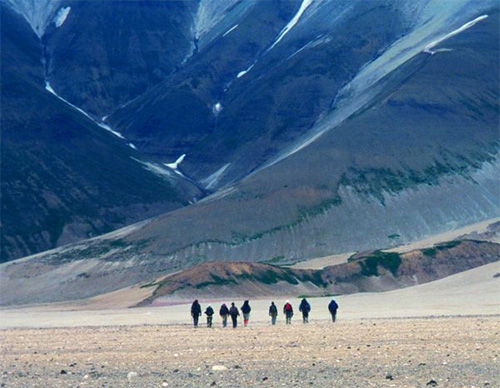Alaska Science Bogoslof’s reminder: Alaska is volcano countryBy NED ROZELL
January 18, 2017
Earthquakes swayed the alders and spruce. A mountain shook, groaned and collapsed into itself, its summit disappearing. About six miles away, hot ash began spewing from the ground in a colossal geyser. During an eruption that lasted three days in 1912, a vibrant landscape became the gray badlands known as the Valley of 10,000 Smokes. The great eruption that created the valley came from a smallish clump of rocks called Novarupta. Nowhere near as grand as Mount Katmai (the mountain that lost its top six miles away), Novarupta spewed an ash cloud 20 miles into the sky, belching 100 times more ash than did Mount St. Helens. Though few people know its name, Novarupta was the largest eruption of the 20th century.
Hikers walk through the Valley of 10,000 Smokes on a trip with volcanologist John Eichelberger in 2001.
From Devon, England, Welchman became enchanted with volcanoes at the age of 13 when she traveled with her family to Hawaii. There, she saw the ocean quenching orange molten rock. Years later, she hiked with volcanologist John Eichelberger on a summer field trip to the Valley of 10,000 Smokes. That trip inspired her to muse about the effects of Novarupta if it happened today, which is quite possible due to the unpredictable nature of Alaska volcanoes (as we see now with the eruption of Bogoslof Island). “I think people in Europe and Asia don’t realize what Alaska could do,” she once said in a cavernous San Francisco poster hall amid hundreds of other scientists as she attended the fall meeting of the American Geophysical Union. “Another Novarupta would be bad news.” Welchman was referring to a similar eruption’s effect on air travel. When Novarupta erupted, there were no planes in the air; the first plane didn’t fly in Alaska until James Martin got airborne from Weeks Field in Fairbanks one year after the eruption. “Now, the North Pacific is one of the busiest air corridors in the world,” Welchman said. “More than 200 flights a day go overhead.” To calculate the effects of a modern-day Novarupta on today’s air travel, Welchman used a computer model called Puff developed by University of Alaska Fairbanks scientists and refined by Peter Webley of the Geophysical Institute. She used the model to spew ash from Novarupta’s vent once a week for five years. She wanted to see which airports in the world would be affected. Almost every one. “Most airports in the Northern Hemisphere would close,” she said. “Europe seems to get the brunt of it, but ash even reached Australia.” Welchman, who hopes to visit more Alaska volcanoes someday soon, summed up Novarupta revisited as follows: “An eruption of Novarupta scale in today’s society has the potential to bring the world to a standstill by affecting the majority of airports in North America and Europe for several days at least,” she wrote on her poster. “The worse case scenario … would cost in excess of $300 million just in terms of passengers and delayed flights.”
Representations of fact and opinions in comments posted are solely those of the individual posters and do not represent the opinions of Sitnews.
|
||

